Vector Problems
Reference > Science > Physics > Study Guide > Unit 3: VectorsThe concept of vectors has been introduced by using examples of displacement vectors. These are probably the easiest type of vector problems because they are the easiest to visualize. There are two other types of vector problems that will be studied in this chapter, velocity and force. Techniques for dealing with velocity and force problems will be developed in the solved problem section.
There are two principal types of force problems:
- Equilibrium problems where it is known that an object is in equilibrium and some of the forces are given. The student then must determine the necessary missing force(s) to produce equilibrium.
- Non-equilibrium problems where all forces are given and it is necessary to combine them to see if the object is in equilibrium, and to determine the magnitude of the unbalanced force, if any, in order to find the object's acceleration.
Non-Equilibrium Vector Problems
Most problems involving addition of velocity vectors are quite straight forward. The typical problem will have some object, a boat or plane for example, which has a known velocity through some medium, air or water, which is itself in motion at a known speed. The resultant velocity of the object will be the vector sum of the two velocities. Sketch a good vector diagram before trying to do any calculations. It is not necessary to construct it to scale but it should be sketched so distances and angles are in approximately the correct proportion to each other. In these types of problems it is usually more logical to sketch the diagram so that a second vector starts at the point of the first. If the two vectors are at right angles to each other the problem can be solved easily by application of the Pythagorean theorem to find the magnitude of the unknown vector and by use of trigonometry to find any unknown angles. If the vectors are not at right angles to each other, draw the diagram as before and then resolve one of the vectors into components which are parallel and perpendicular to the other vector. Both types of problems are illustrated below.
Sample Problem #1
A boat operator in a boat which can travel 15m/sec in still water tries to cross a river which is flowing at 5m/sec by pointing the boat directly across the river. What will be the resultant velocity of the boat?
Sample Solution #1
The first step is to draw a vector diagram as is shown in Figure 3.4.1. In this diagram, VB represents the velocity of the boat, VW represents the velocity of the water and R represents the resultant velocity. The student should be able to show that the resultant velocity is 15.8m/sec at an angle of 18.4º down river.
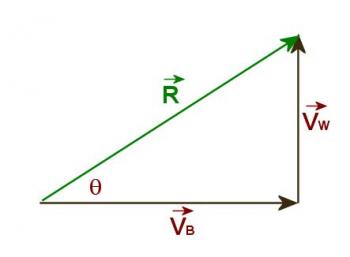
Figure 3.4.1
Sample Problem #2
An airplane can fly at 200mph in still air and wishes to fly due west. There is a wind of 25mph blowing from the south west (exactly half way between south and west). Determine the direction the pilot must point the plane in order to fly in the desired direction and determine the resultant speed of the plane.
Sample Solution #2
See Figure 3.4.2. The directions have been set up as they would be on a map, with west on the left and north at the top of the diagram. An eastwest line is drawn for reference. Since the bearing of the plane is unknown at this point the vector representing the plane's velocity is drawn at a convenient angle south of west. However, the wind is sketched at approximately a 45º angle with the eastâwest line. Also note that the end of the wind vector must lie on the eastâwest line since the plane must end up flying west. The vectors labeled P, W and R stand for the velocity of the plane, velocity of the wind, and resultant velocity respectively. Θ is the required bearing of the plane which is unknown.
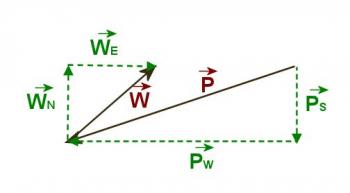
Figure 3.4.2
Since the vectors are not perpendicular to each other it is necessary to pick a convenient set of axes and resolve all the vectors into components parallel to the axes. In this case it seems logical to resolve all vectors into components which are north and east. These are represented by the dotted lines in the diagram and have subscripts N, S,and E to denote which axis they are parallel to.
To find the various vector components proceed as follows:
WN = 17.7 (isosceles triangle)
PW = 200cosΘ and PS = 200sinΘ
Θ = sin-1
The resultant velocity is the west component of the plane's velocity minus the east component of the wind's velocity.
Sample Problem #3
A boat has a constant velocity of 10m/sec east when it encounters a steady wind that blows for 10 seconds. During that 10 seconds the boat has a constant acceleration of 0.3m/sec2 at an angle of 25O N of E. What will be the velocity of the boat at the end of the 10 seconds?
Sample Solution #3
By definition a = ΔV/Δt, therefore ΔV = 3m/sec at 20º N of E. If this value of ΔV is added to the initial velocity the resultant will be the final velocity. See Figure 3.4.3 below. In order to add the two vectors it is easiest to break the vector representing ΔV into north and east components. These are represented by the dotted lines.
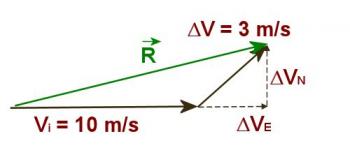
Figure 3.4.3
Calculate the east and north components of V as follows:
VN = Vsin(20) = 3sin(20) = 1.0 m/s
The east and north components of the final velocity are therefore:
RN = 1.0 m/s
Use the Pythagorean theorem and trigonometry to find that the final speed, R, is 12.8m/s at an angle of 4.5º N of E.
Equilibrium Problems
One of the most difficult parts of these problems is in the identification of all forces acting on an object. Remember that you want ALL forces which act on the object, you are not interested in any forces the object exerts on its surroundings. Therefore be sure to draw any vectors in the correct direction. With the exception of field forces (gravitational, electrical and magnetic) all forces will be applied to an object at the point of contact with another object. Usually the magnitudes or directions of one or two forces will be unknown. In these cases estimate the correct position and approximate direction of any unknown force and represent any unknown lengths or angles by variables. At the present time all forces will be concurrent, that is if the force vectors are extended backward they will all meet at a common point. Problems involving nonâconcurrent forces require the notion of torques and rotational equilibrium and will be studied at a later time.
In setting up vector diagrams for these problems it is usually best to draw all vectors originating from a common point. Then select a convenient set of perpendicular axes and resolve all vectors into components parallel to these axes. In most cases the best set of axes will be horizontal and vertical. However be on the alert for situations where a different selection of axes will simplify the problem. For example, with an object resting on an inclined surface the best choice of axes is parallel and perpendicular to the incline rather than vertical and horizontal. After finding the components of the vectors add all components parallel to each set of axes to determine the x and y components of the resultant. Since the object is known to be in equilibrium the sum of the x components and the sum of the y components must both be zero. This will provide two equations and allow you to solve for as many as two unknowns, either forces or angles.
The variety of problems involving the addition of forces is almost endless so it is impossible to give examples of every type of problem. Study the approach to each problem solved below and when you encounter a new type of problem try to apply the same techniques.
Sample Problem #4
A box with a mass of 10kg rests on a frictionless surface which makes an angle of 25O with the horizontal. How large a force must be applied to the box, parallel to the incline to hold the box stationary on the incline?
Sample Solution #4
Sketch a diagram of the box and incline as shown in figure 3.4.4.
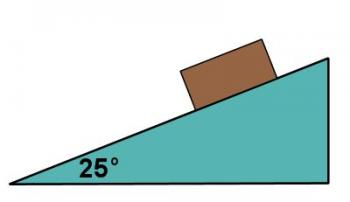
Figure 3.4.4
Then sketch a second diagram showing just the forces acting on the box as shown in Figure 3.4.5.
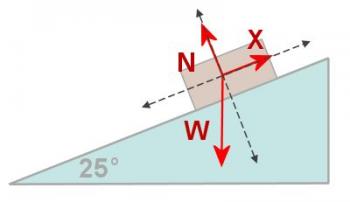
Figure 3.4.5
W represents the weight of the box (not its mass), X represents the unknown applied force, and N represents the normal force applied by the surface on the box. To find the weight remember that
Draw in a convenient set of axes and draw the forces in. In this case the best axes are parallel and perpendicular to the surface of the incline and are shown in Figure 3.4.5. Finally sketch a vector diagram and resolve any vector which does not lie on one of the axes into components parallel to one of the two axes (figure 3.4.6). In this case the only vector which needs to be broken into components is W and its components are shown by dashed lines.
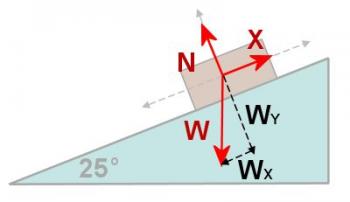
Figure 3.4.6
Now calculate the value of Wx and Wy as follows:
Wy = Wcos(25) = 98cos(25) = 88.8N
Wite an equation setting the total forces in the positive X direction equal to the total forces in the negative X direction. Do the same for the forces in the Y direction.
y components Y = Wy = 88.8N
In this case you are done at this point. The required answer is the force parallel to the incline which is X = 41.4 N. In some cases you will obtain a set of simultaneous equations which must be solved to obtain the desired answer.
Sample Problem #5
A box of mass 10 kg rests on a horizontal floor. The coefficient of sliding friction between the box and the floor is 0.25. A boy pushes the box across the floor at a constant speed. The force is applied downward to the box at an angle of 30º with the horizontal. Calculate the force required.
Sample Solution #5
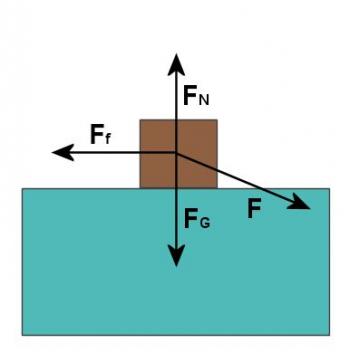
Figure 3.4.7
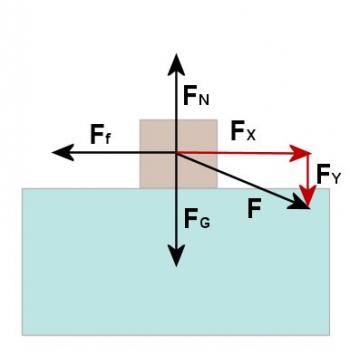
Figure 3.4.8
The force of friction is μ times the normal force. A common error at this point is to set the normal force equal to the weight but this is incorrect. From Figure 3.4.8 it should be obvious that the normal force must be equal to the sum of the weight and the downward component of the applied force. Thus we have:
Ff = μ FN
Fx = Ff
FN = Fy + 98
but:
Therefore:
The student can demonstrate that the solution to this set of equations is:
This problem has many alternate forms and the student should attempt to formulate some of these and solve them or at least be sure that he can draw the proper diagrams. These forms include: The same problem with the force applied horizontally, the same problem with the box being pulled by a rope which makes a certain angle with the horizontal, the same problem with the box on a slope and a force applied parallel to the slope or at some other angle with respect to the slope.
Sample Problem #6
A light rope 10 m long is attached at each end to trees 8m apart at points the same height above the ground. An object having a mass of 50kg is suspended from the rope at a point 4m from one end as shown in figure 3.4.9. Calculate the force in the rope on either side of the object.
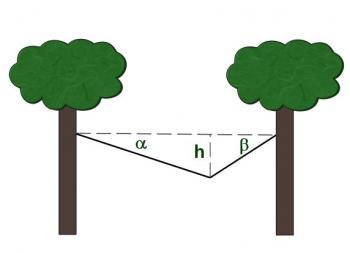
Figure 3.4.9
Sample Solution #6
First it is necessary to determine the angle made with both sections of the rope with the horizontal. Since the rope is attached to the trees at the same height, the distance from the point of attachment to the lowest point is the same on each end. It is labeled H on the diagram. By application of the Pythagorean theorem to each of the two triangles we find that:
Solving these equations we find that:
Use trigonometry to find the values of the two angles, α and ß as follows:
sin(α) =sin(ß) =
Now draw a vector diagram as follows where A and B are the unknown forces.
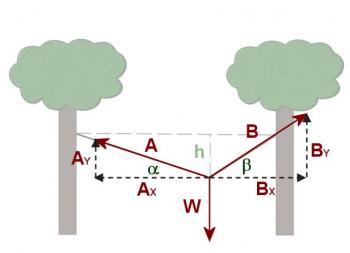
Figure 3.4.10
Find the components of vectors A and B as follows:
Bx = Bcos(46.5) and By = Bsin(46.5)
Since the object is in equilibrium both xâcomponents and yâcomponents are balanced. Therefore
Ax = Bx
Combining all of these equations and recalling that W = Mag = 490 N, we obtain:
Acos(28.9) = Bcos(46.5)
Solve these to obtain:
The following diagrams are used for the practice problems below.
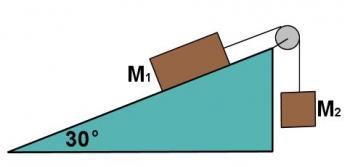
Figure 3.4.11
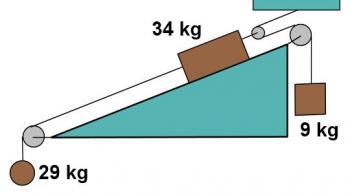
Figure 3.4.12
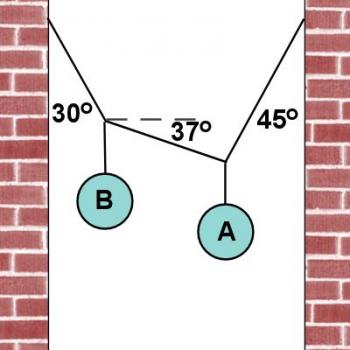
Figure 3.4.13
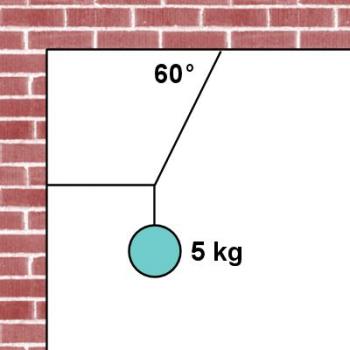
Figure 3.4.14
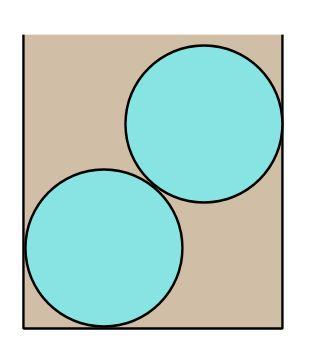
Figure 3.4.15
Questions
 Multiplication of Vectors
Multiplication of Vectors Unit Index
Unit Index

